Recent Rain Patterns and Insecticide Use:
Given our recent periods of rainy weather, many growers are questioning the need for repeated applications, and the weatherability of the materials already applied. Dr. John Wise at MSU has been studying the residual properties of insecticides for a number of years.
In 2018 Dr. Wise published an update on his work on the MSU blog. As noted in the article “rainfastness” of insecticides is influenced by the crop type and time between application and rainfall, in addition to other factors. Below we have reproduced the charts for various fruit crops. We encourage the reader to visit the site and read the full article.
| Rainfastness rating chart: General characteristics for insecticide chemical classes | ||||||
| Insecticide class | Rainfastness ≤ 0.5 inch | Rainfastness ≤ 1.0 inch | Rainfastness ≤ 2.0 inches | |||
| Fruit | Leaves | Fruit | Leaves | Fruit | Leaves | |
| Organophosphates | Low | Moderate | Low | Moderate | Low | Low |
| Pyrethroids | Moderate/High | Moderate/High | Moderate | Moderate | Low | Low |
| Carbamates | Moderate | Moderate/High | Moderate | Moderate | Low | Low |
| IGRs | Moderate | Moderate/High | Moderate | Moderate | Low | Low |
| Oxadiazines | Moderate | Moderate/High | Moderate | Moderate | Low | Low |
| Neonicotinoids | Moderate, Systemic | High, Systemic | Low, Systemic | Low, Systemic | Low, Systemic | Low, Systemic |
| Spinosyns | High | High | High | Moderate | Moderate | Low |
| Diamides | High | High | High | Moderate | Moderate | Low |
| Avermectins | Moderate, Systemic | High, Systemic | Low,Systemic | Moderate, Systemic | Low | Low |
Highly rainfast = ≤ 30% residue wash-off
Moderately rainfast = ≤ 50% residue wash-off
Low rainfast = ≤ 70% residue wash-off
Systemic = Systemic residues remain within plant tissue
| Apple insecticide precipitation wash-off re-application decision chart. Expected codling moth control in apples, based on each compound’s inherent toxicity to codling moth larvae, maximum residual and wash-off potential from rainfall. | ||||||
| Insecticides | Rainfall = 0.5 inch | Rainfall = 1 inch | Rainfall = 2 inches | |||
| *1 day | *7 days | *1 day | *7 days | *1 day | *7 days | |
| Imidan | Sufficient insecticide residue | Insufficient insecticide residue | Sufficient insecticide residue | Insufficient insecticide residue | Insufficient insecticide residue | Insufficient insecticide residue |
| Asana | Sufficient insecticide residue | Insufficient insecticide residue | Insufficient insecticide residue | Insufficient insecticide residue | Insufficient insecticide residue | Insufficient insecticide residue |
| Assail | Sufficient insecticide residue | Sufficient insecticide residue | Insufficient insecticide residue | Insufficient insecticide residue | Insufficient insecticide residue | Insufficient insecticide residue |
| Proclaim | Sufficient insecticide residue | Insufficient insecticide residue | Sufficient insecticide residue | Insufficient insecticide residue | Insufficient insecticide residue | Insufficient insecticide residue |
| Rimon | Sufficient insecticide residue | Sufficient insecticide residue | Insufficient insecticide residue | Insufficient insecticide residue | Insufficient insecticide residue | Insufficient insecticide residue |
| Delegate | Sufficient insecticide residue | Sufficient insecticide residue | Sufficient insecticide residue | Sufficient insecticide residue | Insufficient insecticide residue | Insufficient insecticide residue |
| Altacor | Sufficient insecticide residue | Sufficient insecticide residue | Sufficient insecticide residue | Sufficient insecticide residue | Insufficient insecticide residue | Insufficient insecticide residue |
* Number of days after insecticide application that the precipitation event occurred.
Insufficient insecticide residue = Insufficient insecticide residue remains to provide significant activity on the target pest, and thus re-application is recommended.
Sufficient insecticide residue = Sufficient insecticide residue remaining to provide significant activity on the target pest, although residual activity may be reduced.
| Grape insecticide precipitation wash-off re-application decision chart. Expected Japanese beetle control in juice grapes, based on each compound’s inherent toxicity to Japanese beetle adults, maximum residual and wash-off potential from rainfall. | ||||||
| Insecticides | Rainfall = 0.5 inch | Rainfall = 1.0 inch | Rainfall = 2.0 inches | |||
| *1 day | *7 days | *1 day | *7 days | *1 day | *7 days | |
| Imidan | Sufficient insecticide residue | Insufficient insecticide residue | Insufficient insecticide residue | Insufficient insecticide residue | Insufficient insecticide residue | Insufficient insecticide residue |
| Sevin | Sufficient insecticide residue | Sufficient insecticide residue | Insufficient insecticide residue | Insufficient insecticide residue | Insufficient insecticide residue | Insufficient insecticide residue |
| Brigade | Sufficient insecticide residue | Insufficient insecticide residue | Sufficient insecticide residue | Insufficient insecticide residue | Insufficient insecticide residue | Insufficient insecticide residue |
| Actara | Sufficient insecticide residue | Insufficient insecticide residue | Sufficient insecticide residue | Insufficient insecticide residue | Insufficient insecticide residue | Insufficient insecticide residue |
| Avaunt | Sufficient insecticide residue | Insufficient insecticide residue | Sufficient insecticide residue | Insufficient insecticide residue | Insufficient insecticide residue | Insufficient insecticide residue |
* Number of days after insecticide application that the precipitation event occurred.
Insufficient insecticide residue = Insufficient insecticide residue remains to provide significant activity on the target pest, and thus re-application is recommended.
Sufficient insecticide residue = Sufficient insecticide residue remaining to provide significant activity on the target pest, although residual activity may be reduced.
| Blueberry insecticide precipitation wash-off re-application decision chart. Expected cranberry fruitworm control in blueberries, based on each compound’s inherent toxicity to cranberry fruitworm larvae, maximum residual and wash-off potential from rainfall. | ||||||
| Insecticides | Rainfall = 0.5 inch | Rainfall = 1.0 inch | Rainfall = 2.0 inches | |||
| *1 day | *7 days | *1 day | *7 days | *1 day | *7 days | |
| Asana | Sufficient insecticide residue | Insufficient insecticide residue | Insufficient insecticide residue | Insufficient insecticide residue | Insufficient insecticide residue | Insufficient insecticide residue |
| Intrepid | Sufficient insecticide residue | Insufficient insecticide residue | Insufficient insecticide residue | Insufficient insecticide residue | Insufficient insecticide residue | Insufficient insecticide residue |
| Assail | Sufficient insecticide residue | Insufficient insecticide residue | Sufficient insecticide residue | Insufficient insecticide residue | Insufficient insecticide residue | Insufficient insecticide residue |
| Delegate | Sufficient insecticide residue | Insufficient insecticide residue | Sufficient insecticide residue | Insufficient insecticide residue | Insufficient insecticide residue | Insufficient insecticide residue |
* Number of days after insecticide application that the precipitation event occurred.
Insufficient insecticide residue = Insufficient insecticide residue remains to provide significant activity on the target pest, and thus re-application is recommended.
Sufficient insecticide residue = Sufficient insecticide residue remaining to provide significant activity on the target pest, although residual activity may be reduced.
| Blueberry insecticide precipitation wash-off re-application decision chart. Expected Japanese beetle control in blueberries, based on each compound’s inherent toxicity to Japanese beetle adults, maximum residual and wash-off potential from rainfall. | ||||||
| Insecticides | Rainfall = 0.5 inch | Rainfall = 1.0 inch | Rainfall = 2.0 inches | |||
| *1 day | *7 days | *1 day | *7 days | *1 day | *7 days | |
| Imidan | Insufficient insecticide residue | Insufficient insecticide residue | Insufficient insecticide residue | Insufficient insecticide residue | Insufficient insecticide residue | Insufficient insecticide residue |
| Mustang Max | Sufficient insecticide residue | Insufficient insecticide residue | Sufficient insecticide residue | Insufficient insecticide residue | Insufficient insecticide residue | Insufficient insecticide residue |
| Sevin | Sufficient insecticide residue | Insufficient insecticide residue | Insufficient insecticide residue | Insufficient insecticide residue | Insufficient insecticide residue | Insufficient insecticide residue |
| Provado
Admire |
Sufficient insecticide residue | Insufficient insecticide residue | Insufficient insecticide residue | Insufficient insecticide residue | Insufficient insecticide residue | Insufficient insecticide residue |
* Number of days after insecticide application that the precipitation event occurred.
Insufficient insecticide residue = Insufficient insecticide residue remains to provide significant activity on the target pest, and thus re-application is recommended.
Sufficient insecticide residue = Sufficient insecticide residue remaining to provide significant activity on the target pest, although residual activity may be reduced.
| Blueberry insecticide precipitation wash-off re-application decision chart. Expected spotted wing Drosophila control in blueberries, based on each compound’s inherent toxicity to SWD, maximum residual and wash-off potential from rainfall. | ||||||
| Insecticides | Rainfall = 0.5 inch | Rainfall = 1.0 inch | Rainfall = 2.0 inches | |||
| *1 day | *7 days | *1 day | *7 days | *1 day | *7 days | |
| Imidan | Sufficient insecticide residue | Insufficient insecticide residue | Sufficient insecticide residue | Insufficient insecticide residue | Insufficient insecticide residue | Insufficient insecticide residue |
| Mustang Max | Sufficient insecticide residue | Insufficient insecticide residue | Sufficient insecticide residue | Insufficient insecticide residue | Insufficient insecticide residue | Insufficient insecticide residue |
| Lannate | Sufficient insecticide residue | Insufficient insecticide residue | Sufficient insecticide residue | Insufficient insecticide residue | Insufficient insecticide residue | Insufficient insecticide residue |
| Malathion | Insufficient insecticide residue | Insufficient insecticide residue | Insufficient insecticide residue | Insufficient insecticide residue | Insufficient insecticide residue | Insufficient insecticide residue |
| Delegate | Insufficient insecticide residue | Insufficient insecticide residue | Insufficient insecticide residue | Insufficient insecticide residue | Insufficient insecticide residue | Insufficient insecticide residue |
| Assail | Insufficient insecticide residue | Insufficient insecticide residue | Insufficient insecticide residue | Insufficient insecticide residue | Insufficient insecticide residue | Insufficient insecticide residue |
* Number of days after insecticide application that the precipitation event occurred.
Insufficient insecticide residue = Insufficient insecticide residue remains to provide significant activity on the target pest, and thus an immediate re-application is recommended.
Sufficient insecticide residue = Sufficient insecticide residue remaining to provide significant activity on the target pest, although residual activity may be reduced.
| Insecticide persistence, plant penetration and rainfastness rating | |||
| Compound class | Persistence (residual on plant) | Plant penetration characteristics | Rainfast rating |
| Organophosphates | Medium – Long | Surface | Low |
| Carbamates | Short | Cuticle Penetration | Moderate |
| Pyrethroids | Short | Cuticle Penetration | Moderate – High |
| Neonicotinoids | Medium | Translaminar & Acropetal | Moderate |
| Oxadiazines | Medium | Cuticle Penetration | Moderate |
| Avermectins | Medium | Translaminar | Moderate |
| IGRs | Medium – Long | Translaminar | Moderate |
| Spinosyns | Short – Medium | Translaminar | Moderate – High |
| Diamides | Medium – Long | Translaminar | Moderate – High |
Peach:
Plum curculio (PC): We continue to see scattered but recent egg laying scars in peaches Figure 1). We are long past the usual need for insecticides, but some recent injury was seen last week on nectarines. We are also seeing considerable evidence in blueberries. No additional insecticides are needed for this pest, but the presence of ‘late season’ injury does point to a heavier than normal overwintering population.
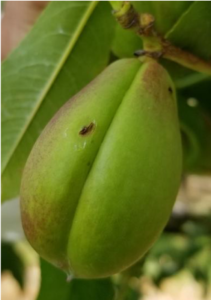
Figure 1. New PC injury on nectarine during early June. Photo – A. Atanassov
Oriental Fruit Moth: Second generation timings are updated below. Second flight adults started this past week in southern counties and are about to start this coming week in northern counties. According to the model, treatments for the second generation should be going on now in southern counties, and should start next week in northern counties.
| OFM 2nd Degree Day (DD) Timing | ||||
| Insecticide Type | ||||
| County/Region | Biofix | DD by 6/13 base 45 | Conventional
1150-1200, 1450-1500 |
Diamide
1075-1150, 1375-1450 |
| Gloucester – Southern | 4/8 | 1327
|
1st – past
2nd – 6/18-6/20 |
1st – past
2nd – 6/15-6/18 |
| Hunterdon – Northern | 4/16 | 960 | 1st – 6/21-7/23
2nd – too far off |
1st – 6/18-6/21
2nd – too far off |
Bacterial Spot: Infection levels increased dramatically statewide in susceptible varieties. While fruit has developed some resistance, less severe symptoms may still appear from infections that occur after pit hardening. Severe symptoms from infections that occurred before pit hardening may continue to appear for the next 3 weeks. Bacterial spot is usually more common in southern county orchards on sandy soils. This past week we saw the disease on northern counties on the fruit (Figure 1). In one instance in a nectarine planting (usually more susceptible than many peach varieties), an end tree was more affected than others in the row, implying that the grower may have missed coverage on a turn. An indicator like this demonstrates the importance of maintaining good coverage of coppers (Champ, Cueva, Magna-Bon, Nu-Cop) or Mycoshield/FireLine. Coverage should continue as long as any of the following criteria are met: 1) Frequent rains and infection periods, 2) Presence of bacterial spot foliar inoculum, 3) Presence of bacterial spot symptoms on the fruit, and 4) any of the previous conditions when fruit is greater than 3 weeks from picking.
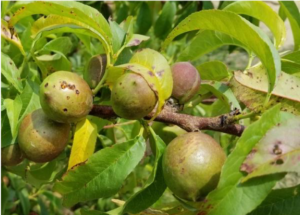
Figure 2. Bacterial spot on nectarine fruit and leaves during early June. Photo – A. Atanassov
Peach Scab: Maintain good coverage with captan or other effective fungicides until July, where scab was an issue last year.
Rusty Spot: No further control of rusty spot should be needed this season.
Brown Rot: After pit hardening growers may safely switch to a sulfur based program on late variety peaches where no scab was present last year. Pre-harvest programs for early peaches may rely on captan alone at the present time. As we approach ripening of midseason varieties growers should begin applying highly effective materials that include DMI, SDHI, and QoI chemistries beginning 3 weeks prior to harvest.
Apple:
Codling Moth (CM): The first codling moth flight has started. A biofix was set for CM on April 25th in southern counties and on May 1 in Hunterdon County. Although we are past the model timings for CM, some orchards continue to experience trap captures above threshold. Growers should continue to treat for this insect as long as trap counts are above the treatment threshold of 5 males per trap. The average trap capture on many farms continues to indicate CM populations above this threshold, even after 2 well timed treatments (See graph below). It is possible that over the years, a second ‘race’ developed that might have a longer diapause, escapes the first sprays, and then emerges after many of the first insecticides are applied. This produces a longer and more difficult to control first generation. This is also what may be happening in the second generation.
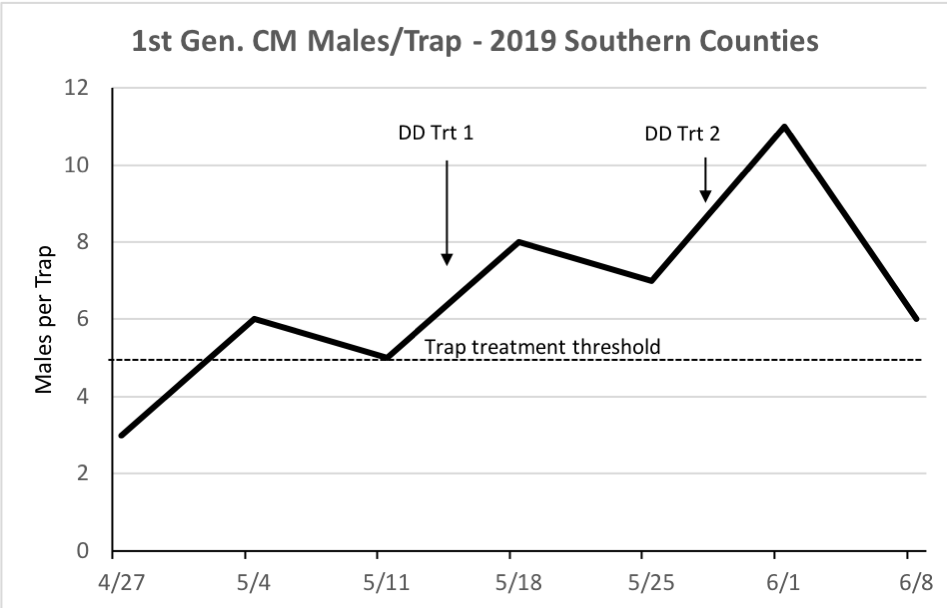
First flight codling moth in southern counties showing degree timed insecticides and trap counts still above treatment threshold.
Tufted Apple Budmoth (TABM): A biofix for TABM was set in southern county orchards on 4/25. The fourth alternate middle application for TABM will be this week in southern counties. A number of sites in northern counties have trap counts that range from 48 to over 90 males per trap. If we were still using an organophosphate-based program, this would probably spell trouble. However, management practices have changed, and we have not seen problems in recent years.
Fire Blight: Shoot blight symptoms increased in susceptible varieties over the past week. Those growers with shoot blight symptoms should cut out the strikes, and continue to use protective copper applications. Doing nothing will likely result in a considerable higher level of fire blight, and possible tree death, depending on the variety and rootstock.
Rosy Apple Aphid (RAA): A few colonies are still active in northern orchards. While these should be leaving for alternate hosts, they don’t usually do so until mid-summer when they produce winged forms and leave the apple trees. Two common alternate weed hosts include curly dock and narrow leaf plantain – one good reason to have good weed control in your orchard middles. At the present time most colonies are still in the mode of females producing more non-winged females. Since damage can be severe, there is a low treatment threshold of one colony per tree. Effective materials include any neonicotinoid (Assail, Actara, Admire, Belay), Beleaf, and Sivanto. Belay and Actara, as well as premixes that include those active ingredients, are also effective for brown marmorated stink bug (BMSB).
Grapes
Approximately 20% of the samples last week on 4 southern county vineyards displayed symptoms of Phomopsis. Downy Mildew symptoms are now appearing but have not been noted in routine scouting.
Bloom is the most important time for disease control in the vineyard. Targets at this time are the downy and powdery mildew, black rot, bunch rot, and botrytis.
A biofix was set for Grape berry moth in southern counties on 5/13. Check wild vines near your vineyard and note the date of about 50% bloom. This is the biofix. As of 6/10 we have accumulated 605 dd base 47.14 deg F in southern counties. The target for intrepid and Altacor is after 810 dd have accumulated. This target should be on or about 6/24 in southern counties. Other materials can be a applied a few days later.
| WEEK END | GBM | GRB |
| 6/1/2019 | 0 | |
| 6/8/2019 | 9 |
The following table is intended as an aid for orchard scouting. I t should not be used to time pesticide applications. Median dates for pest events and crop phenology are displayed. These dates are compiled from observations made since 1995 in Gloucester County. Events in northern New Jersey should occur 7-10 days later.
Pest Event or Growth Stage |
Approximate Date | 2019 Observed Date |
| Bud Swell (Redhaven) | March 23 +/- 15 Days | March 25 |
1/4″ Green Tip Red Delicious |
March 31 +/- 13 Days | March 27 |
Pink Peach (Redhaven) |
April 4 +/- 15 Days | April 4 |
Tight Cluster Red Delicious |
April 9 +/- 13 Days | April 8 |
Oriental Fruit Moth Biofix |
April 9 +/- 13 Days | April 8 |
Full Bloom Peach (Redhaven) |
April 9 +/- 14 Days | April 9 |
Pink Apple (Red Delicious) |
April 14 +/- 12 Days | April 16 |
Codling Moth Biofix |
April 27 +/- 13 Days | April 25 |
Green Peach Aphid Observed |
April 16 +/- 16 Days | |
Full Bloom Apple (Red Delicious) |
April 22 +/- 11 Days | April 20 |
Petal Fall (Redhaven) |
April 22 +/- 10 Days | April 19 |
Petal Fall (Red Delicious) |
April 27 +/- 14 Days | April 29 |
Shuck Split (Redhaven) |
April 30+/- 11 Days | April 24 |
First PC Oviposition Scars Observed |
May 3 +/- 18 Days | April 23 |
Tufted Apple Bud Moth Biofix |
May 4 +/- 10 Days | April 8 |
San Jose Scale Crawlers |
June 2 +/- 8 Days | May 24 |
Pit Hardening Peach |
June 16 +/- 8 Days | Just past |
Tree Fruit Trap Counts – Southern Counties
| Weekending | STLM | TABM-A | CM | AM | OFM-A | DWB | OFM-P | TABM-P | LPTB | PTB |
| 4/27 | 8 | 1 | 3 | 110 | 29 | 0 | ||||
| 5/4 | 4 | 5 | 6 | 34 | 17 | 1 | 0 | |||
| 5/11 | 2 | 8 | 5 | 31 | 5 | 5 | 0 | |||
| 5/18 | 2 | 32 | 8 | 21 | 23 | 2 | 11 | 34 | ||
| 5/25 | 2 | 34 | 7 | 0 | 39 | 0 | 32 | 34 | ||
| 6/1 | 1 | 51 | 11 | 1 | 71 | 1 | 56 | 47 | ||
| 6/8 | 13 | 25 | 6 | 14 | 2 | 26 | 56 |
Tree Fruit Trap Counts – Northern Counties
| Weekending | STLM | TABM-A | CM | AM | OFM-A | DWB | OBLR | OFM-P | TABM-P | LPTB | PTB |
| 4/6 | 0.3 | ||||||||||
| 4/13 | 2 | ||||||||||
| 4/20 | 10 | 0 | 0.2 | 0.9 | |||||||
| 4/27 | 9 | 0 | 0 | 4 | 9.5 | 0 | |||||
| 5/4 | 9 | 0.1 | 0.2 | 7 | 0 | 0 | 17.1 | 0.2 | 0 | ||
| 5/11 | 10 | 0.6 | 1.2 | 4 | 0 | 0 | 5.8 | 2 | 2.5 | 0 | |
| 5/18 | 6 | 2.7 | 0.8 | 5 | 0 | 0 | 5.6 | 5.2 | 1.4 | 0 | |
| 5/25 | 3 | 13.3 | 2.9 | 3 | 2 | 0 | 1.1 | 10.8 | 4.5 | 0 | |
| 6/1 | 5 | 22.4 | 3.2 | 4 | 4 | 0.5 | 3.1 | 14.7 | 5.7 | 0 | |
| 6/8 | 8 | 40.4 | 3.8 | 1 | 1.3 | 2 | 1.7 | 32.5 | 8.3 | 0.3 |
Blueberry
Plum Curculio (PC): Fruit injury over the past week averaged 0.03% with a maximum of 0.7% fruit injury. Most injured fruit is dropping to the ground, and any infested fruit still on the bushes is prematurely soft. If you have ANY PC injured fruit in your harvest, make sure to set your firmness sorters so they kick any of this out in the cull tray.
Scale: Scale crawlers are still present, and causing a low level of fruit injury where present. One field has up to 1.3% of fruit marked with scale, but the average injury is closer to .04%. These fields should be scheduled for a scale treatment during the second crawler generation during late July to early August.
Leafroller larval presence and injury: Presence of larvae was very low this past week, with 0.04% of shoots infested, and a maximum of 2%. Fruit injury was also very low but still present.
Cranberry and Cherry Fruitworm (CBFW, CFW): Some slight amount of injury and pest injury is present, but overall is not a concern. Some non to poorly sprayed fields showed a higher presence of cherry fruitworm this year than cranberry fruitworm. Cherry fruitworm larvae are pink to orange (See photo), and do not produce the massive amounts of frass associated with cranberry fruitworm, which is light green.
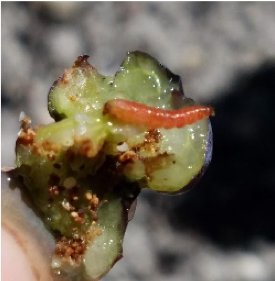
Figure 3. Mature cranberry fruitworm larva in berry. Photo – C. Denson
Aphids: During the past week the average level of infested terminals was just over 2% with a maximum present of 24%. Colony sizes have increased to 2-5 aphids per colony. Aphids should be well controlled at this point, since SWD is now part of the pest picture.
Spotted Wing Drosophila (SWD): This is now the main pest of concern. The majority of our trap network consists of red sticky traps with an SWD attractant hung below the trap. We count only males in this trap, since this is far more economical than using a network of cup traps that have to be strained each week to ID the flies. These are the numbers reported in the trap table below. However we do have several cup traps placed at 4 locations to look at early female presence. Our first SWD capture was just prior to Memorial Day. With temperatures in the low 80’s, SWD can go through a generation in about 10 days. Considering the number of eggs a female can produce, with ideal temperatures, a 2nd generation could produce 100x that of the 1st generation first seen in late May. As the population density increases during the growing season, SWD pressure becomes greater. Protection of the fruit is more difficult, and the likelihood of infested berries increases. This is why it is important to start early, and stay on top of SWD management. Watch the weather and try not to apply certain materials if significant rain is predicted for the next day. See John Wise’s tables MSU.
Cup Traps Including Female SWD 6/2-6/8
| Atlantic Location 1 | Atlantic Location 2 | Burlington | |
| Females | 4 | 4 | 1 |
| Males | 9 | 16 | 6 |
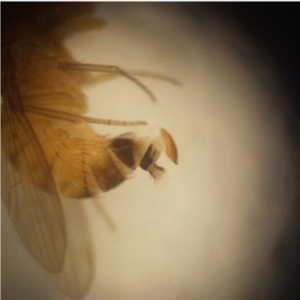
Figure 4. Female SWD showing comb-like ovipositor. Photo – C. Denson
Full Season Traps
Atlantic County Traps
| SWD | OB | BBM | |
| Average | 1.05 | 8.2 | 0 |
| High | 12 | 50 | 0 |
Burlington County Traps
| SWD | OB | BBM | |
| Average | 0.07 | 2.91 | 0 |
| High | 1 | 14 | 0 |

